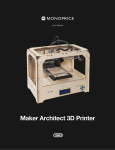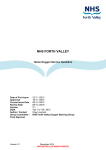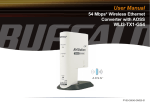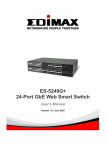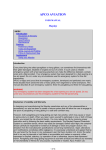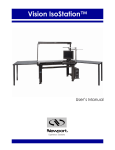Download Buffalo Technology PC-P1LAN Network Card User Manual
Transcript
Network Media Player PC-P1LAN User’s Manual Using Link Theater Detailed Configuration Appendix Contents Using LinkTheater Supported file formats.......................................... 3 Registering playback folders............................... 4 Data playback on a television.............................. 4 Converting files..................................................... 4 Configuring access restrictions.......................... 6 DLNA media server playback . ............................. 8 Detailed Settings LinkTheater Advanced Settings........................... 9 Media Server Configuration................................ 10 BootServer Manager........................................... 11 Appendix Manually configuring an IP address ................. 12 Verifying computer’s IP address.......................... 12 Configuring the LinkTheater's IP address........... 14 Troubleshooting.................................................. 16 Glossary............................................................... 21 Specifications...................................................... 22 Using this manual The following notations and symbols are used throughout this manual. Notations and Symbols Caution are items that you must pay particular attention to Caution mark................. Items which follow when handling Link Theater. Failure to follow this mark may result in personal injury and/or damage to the device. Next operation mark...... Page numbers that come after next. indicate the page you should proceed to Terminology notation within the manual •This manual assumes that your computer has the following drive configuration: C: Hard disk E: CD-ROM drive •Names enclosed in [ ] brackets within the manual represent dialog box names, menus, buttons, check boxes or other such items that you need to select when operating the device. •Names enclosed in < > brackets represent keys on the keyboard. (Example) <Enter> Using LinkTheater Thank you for choosing LinkTheater! This manual should help you configure and use your new LinkTheater. Supported file formats The following file formats can be played back using LinkTheater. Media Server trans code compatible format (*1) AVI (*2), WMV, WMA, GIF • Audio files encoded in either MP3 or WAV (uncompressed) Compatible formats • Image files saved/compressed in JPEG, BMP or PNG formats • Video files encoded in MPEG-2 format Compatible video formats Image section digital compression format • MPEG-2 standard resolution (*.MPG file, m2p file) Audio section digital compressed • MPEG-1 Audio Layer 2 2 channel • MPEG-1 Audio Layer 3 2 channel Audio section digital uncompressed Linear PCM Compatible audio formats Compatible image formats • Maximum resolution 720 x 480 Maximum 8Mbps (*3) • Maximum frame rate 30fps (S/P DIF) 2 channel 16 bit, 48kHz • Linear PCM (*.WAV) • MPEG-1 Audio Layer -3 (*.MP3) • JPEG (*4), BMP, PNG *1: LinkTheater plays MPEG-2 and MP3 files. Other formats are transformed into MPEG-2 and MP3 for playback. For format transformation, your PC should meet the following requirements. ■ Minimum system requirements [CPU] Pentium4 1.4GHz or higher, or equivalent performance CPU [Memory] 256 MB or higher ■ Recommended system requirements [CPU] Pentium4 1.8GHz or higher/ Celeron 1.8GHz or higher/ Pentium M 900MHz or higher Celeron M 1.0GHz or higher, or equivalent performance CPU recommended. [Memory] 512 MB or higher recommended. *Low bit rates may allow some files to play from PCs that do not meet the above requirements. *Not all files can be played. *2: The AVI codec must be installed in your computer to convert and play AVI files. *3: If LinkTheater is connected to an 11Mbps wireless LAN, or if playback is performed from an USB1.1 device, demanding video files (3Mbps or more) may skip or drop frames. *4: Only baseline JPEGs can be viewed. Registering a folder for playback In order to play computer files on LinkTheater, you need to register the folders on the computer. Refer to the separate [Read Me First] document, and register your media folders for playback. Data playback on a television Refer to the separate [Read Me First] document for details on the procedure for playing back computer or server data on a television. Note LinkTheater can play MPEG-2 and MP3 files. Other formats are automatically transformed for playback. You can change the image quality by right-clicking on the Transcoder's task tray icon and selecting Quality from the displayed menu, or as shown below. Converting data When videos cannot be played smoothly because of dropped frames, or if you want to play back MPEG-2 files that have a bitrate higher than 8Mbps, you need to convert the files on your computer before playback, as shown below. 1 Click [Start]-[(All) Programs][BUFFALO]-[PC-P1LAN][Transcoder]-[Transcoder]. 2 Drag and drop the file that you want to convert. * In order for you to distinguish between explanations concerning the television screen and computer screen and explanations about the computer screen are marked with this icon . * Screens shown in this manual are examples. Your display may be slightly different. Mini LinkTheater User’s Manual 3 Click [Edit Settings]. 4 Select the compression quality, then click [OK]. If you wish to configure image quality settings individually, click [Add] in step 4 on page 4, and set the details as desired. Individual items can be selected under [New Profile]. The following items can be set. 5 Click [Add]. Mode Mode can be selected from constant bitrate (CBR), variable bitrate (CVBR), and constant quality (CQ). The features of each mode are explained in the [Glossary] on page 21. Items that can be set in [Rate settings] differ depending on the mode selected here. Maximum Bitrate This setting is the maximum bitrate used when recording. This can only be set when [Variable Bitrate] is selected in adjustment mode. It is possible to set a value in the range of the [Bitrate] value in the item above ~8000 (kbps). 6 [Status] displays [Awaiting conversion] → [Converting] → [Conversion completed]. DeInterlacing “Bob” interlacing produces the sharpest image but may leave noise artifacts. “Median” interlacing reduces noise but may remove image detail. Note To stop the conversion process, click [Stop]. Click [Start] to restart a stopped file. Audio bitrate A high bitrate provides higher sound quality, but it also increases the size of the file. Mini LinkTheater User’s Manual Appendix CPU processing speed Image quality improves with a larger value, but the strain placed on the CPU (computer) also increases. Use higher numbers if you have a fast computer. Normally, a value in the range of 0~2 is used. Detailed Configuration Minimum Bitrate This setting is the minimum bitrate used when recording. This can only be set when [Variable bitrate] is selected in adjustment mode. It is possible to set a value in the range of the [Bitrate] value in the item above ~192 (kbps). Note You can specify the save destination and name of the file after conversion by clicking [Output file]-[Browse]. By default, the converted file is added and saved to the same location as the conversion source file, and [MPEG2 (PC-P1LAN)]_000 is added to the end of the file name (the 000 number counts up when the same name file is converted a number of times). Using LinkTheater Bitrate The larger the set value, the clearer the image will be. However, the size of the recorded file also increases. The possible setting range is 192~8000 (kbps). If [Variable Bitrate] is selected in adjustment mode, recording is performed within the range of bitrates set for maximum bitrate and minimum bitrate. Set this value so that it falls between the [Maximum Bitrate] and [Minimum Bitrate] which will be set below. Configuring access restrictions You can set access restrictions to shared playback folders, so that the folder can only be played back when specific conditions are met. These settings can be performed as follows. 1 Click [Start]-[(All) Programs][BUFFALO]-[PC-P1LAN][Configure Media server]. 2 Click the [Permissions] tab. 3 Click [Turn ON Access Control]. Mini LinkTheater User’s Manual 4 Click [Only accept access from the following client devices]. When you want to prohibit specific conditions, select [Prohibit access from the following client devices]. 5 Click [Add]. 6 Click [Next]. 7 Select the conditions for access restriction, then click [Next]. Using LinkTheater You can select restriction conditions of host name, IP address, network address, and MAC address (get MAC address from the back of your LinkTheater). Detailed Configuration Appendix Step through the wizard to complete the access restriction settings. Mini LinkTheater User’s Manual Playing back DLNA compatible media server data About DLNA (Digital Living Network Alliance) DLNA (Digital Living Network Alliance) has defined product design guidelines [Home Network Device Interoperability Guidelines] with the aim of standardizing electronic industry technology and realizing an interconnected environment of digital equipment (computers, household appliances, mobile devices). LinkTheater can play media files from DLNA compatible media servers such as the Buffalo LinkStation HS-DGL Home Server series. Select "HOME Server" (the DLNA compatible media server) from the LinkTheater Home screen, and press the [Select/Play] button on the remote control. Your DLNA media server may not have DLNA functionality turned on by default. For LinkTheater to stream media from a DLNA server, DLNA must be turned on! This is not always the default setting. Refer to your DLNA media server's manual for more information on enabling DLNA media server functionality. Mini LinkTheater User’s Manual Advanced Settings Normally, you won't need to change these settings. Here's explanations of each in case you do. LinkTheater Advanced Settings . 1 Press the power button and start LinkTheater. 3 You can configure each of these items. Using LinkTheater * Screens shown in this manual are examples. Your display may look slightly different. Select [Settings], and press button. The following settings can be performed in [Edit Profile]. Obtain automatically (DHCP): If there is a DHCP server on the network, an IP address is assigned automatically. Manual settings: You can also manually enter the IP address and subnet mask. The settings are enabled by selecting the items edited above in [Profile selection], and pressing the [Select/Play] button on the remote control. • Display settings In [Screensaver], you can set the amount of time (1~60 minutes) before the screensaver starts on the television screen when there are no operations performed. You can set the amount of time (3 seconds — 2 minutes) that a photograph is displayed on the television screen in [Photo display interval]. • (Firmware) Version This displayes the firmware version number. Mini LinkTheater User’s Manual Appendix 2 • (Wired) Network settings Detailed Configuration * In order for you to distinguish between explanations concerning the television screen or computer screen, explanations about the television screen are marked with this icon . Media Server Configuration You can register folders that will be played on LinkTheater and also set access restrictions. Click [Start][(All) Programs]-[BUFFALO]-[PC-P1LAN]-[Configure Media server] to display the settings screen. Shared folder screen • Add Registers folders that contains files that you want to play on the LinkTheater. • Delete By selecting a folder and clicking [Delete], registration of the shared folder is deleted. • Update This updates the shared folder and file display. • Automatic search This starts the automatic search wizard. You can find folders on the computer that contain video, audio, and image files by using the automatic search wizard. Settings screen • Enable file sharing on computer startup This setting enables file sharing when the computer starts up. • Display icon in task tray when program is closed This setting displays an icon in the task tray when [Media server settings] is closed. • Default settings Restores Media server settings to the initial settings. • Do not share files This setting disables file sharing. • Share files This setting enables file sharing. 10 Mini LinkTheater User’s Manual BootServer Manager Access restrictions screen You can set firmware rewrite (FW) and enable/ disable server functions using the BootServer administration tool. Click [Start]-[(All) Programs][BUFFALO]-[PC-P1LAN]-[BootServer Manager] to start the tool. BootServer Management screen • Enable access restrictions This setting enables access restrictions. This is not displayed if the settings are already enabled. • Disable access restrictions • Only allow access from the following client devices This detects BootServer media servers on the network. • Check all This displays a check mark in the check boxes for all detected servers. This setting only allows access from devices listed in [Restriction rules]. • Clear All This cannot be selected when access restrictions are disabled. • Update Firmware Removes all of the check mark displays. This cannot be selected when access restrictions are disabled. • Add Detailed Configuration This updates checked server firmware. • Prohibit access from the following client devices This setting prohibits access from the devices listed in [Restriction rules]. Using LinkTheater This setting disables access restrictions. This is not displayed if the settings are already disabled. • Detect servers [FW version after rewrite] displays the version number after rewrite. • Turn ON Server Enables servers that have a check mark displayed. • Turn OFF Server Disables servers that have a check mark displayed. * Do not disable all servers on the network, or the PC-P1LAN startup screen will not be displayed. You need at least one BootServer media server to use the LinkTheater. You can set allow/prohibit conditions (host name, IP address, network address, MAC address) using this wizard. This cannot be selected when access restrictions are disabled. • Delete You can delete conditions by selecting them in [Restriction rules] and clicking [Delete]. Caution An icon is displayed in the task tray when your computer is running the BootServer media server. If no icon is displayed, the PC-P1LAN startup screen will not be displayed. Click [Start]-[(All) Programs][BUFFALO]-[PC-P1LAN]-[PC-P1LAN BootServer] to launch the BootServer media server on your PC. Mini LinkTheater User’s Manual 11 Appendix This starts the Add access restrictions wizard. Appendix This section gives proceedures for manually setting IP addresses, describes firmware update procedures and the procedure for playing back LinkStation data, addresses basic troubleshooting, and gives device specifications. For customers that do not have a router (Procedure for manually configuring the IP address) If you have no router on your network and connect your LinkTheater directly to your PC, you'll need to set the IP address manually. To do this, you'll need to determine the IP address and subnet mask for your computer. Only configure the LinkTheater's IP address manually if you have a good reason for doing so, e.g. you are not using a router, or your network has no DHCP server. Note The numbers and letters that are displayed on the screen will differ according to your environment. Checking the computer’s IP address 1 Click the menu below and start the command prompt. 2 [C:\>] is displayed on the screen. Type [IPCONFIG/ALL], and press the <ENTER> key. 3 The IP address is displayed in the [IP Address] column, and the subnet mask is displayed in the [Subnet Mask] column. Select [Start] - [(All) Programs] - [Accessories] - [Command prompt]. C:\>IPCONFIG/ALL Ethernet adapter local area connections IP address : 192.168.11.2 Subnet Mask : 255.255.255.0 Check Connection-specific DNS Suffix : Description : BUFFALO LGY-PCI-TXD Ethernet Adapter Physical Address : DHCP Enabled : Yes Default Gateway : 192.168.0.1 DNS Servers : 192.168.0.1 Now you know your computer's IP address. See page 13 for more on LinkTheater's IP address and Subnet mask. Continue to page 14 to set LinkTheater's IP address and subnet mask. 12 Mini LinkTheater User’s Manual What is the LinkTheater IP address value? Set the following values for the LinkTheater IP address. Computer IP address LinkTheater IP address When the IP address is 192.168.11.2 Set to 192.168.11.12. Set the same value Set a different number from the computer between 2 and 254 What is the LinkTheater Subnet mask value? Set the LinkTheater subnet mask value to the same value as the computer’s subnet mask value. Computer’s subnet mask LinkTheater subnet mask When the value is 255.255.255.0 Set this to 255.255.255.0. Set the same value Using LinkTheater Detailed Configuration Appendix Mini LinkTheater User’s Manual 13 Configuring the LinkTheater's IP address 1 2 3 14 4 Select [Edit Network Profile] , and press button. 5 Select [Static], and press button. 6 Enter the IP address and subnet mask, and press the [Select/Play] button. Press the power button and start LinkTheater. Select [Settings], and press button on the directional pad. Select [Network], and press button. Mini LinkTheater User’s Manual Caution Make sure the LinkTheater's IP address is not the same as the computer’s IP address. If you are not sure of the value to set, see page 12. Example: If the computer’s IP address is [192.168.11.2] and the subnet mask is [255.255.255.0], then set the LinkTheater's IP address to [192.168.11.12] and the subnet mask to [255.255.255.0]. Note The IP address and subnet mask can be entered using the ten key buttons on the remote control. You can enter a "." (decimal point) by pressing the [1] button twice in succession. 8 Select [Select Network profile] , and press button. 9 Select [Static], and press button. Detailed Configuration By pressing button twice, you can return to the screen in procedure 4. Using LinkTheater 7 Appendix Your LinkTheater is now configured with a static IP address. Mini LinkTheater User’s Manual 15 Troubleshooting I cannot switch the power on Cause: The power cord is disconnected from the wall socket or LinkTheater Solution: Connect the power cord to the wall socket or LinkTheater I cannot see videos or hear sounds Cause (1): The connection to the television is incorrect Solution (1): Connect the television correctly Cause (2): The correct video input has not been selected on the TV Solution (2): Select from inputs that are connected to LinkTheater, for example “video”, etc. Cause (3): The LInkTheater or television mute function is enabled Solution (2): Press the [Mute] button on the remote control to disable the mute function. Refer to the manual that came with your television for details on how to disable the television’s mute function. Cause (4): DirectX has a problem, or has been deleted Solution (4): Insert the CD provided into the computer's CD drive, and select [Install DirectX] from easy setup. Then follow subsequent onscreen messages to install DirectX. The remote control doesn’t work Cause (1): There are no batteries inside the remote control Solution (1): Set batteries inside the remote control 16 Mini LinkTheater User’s Manual Cause (2): The batteries are exhausted Solution (2): Replace the old batteries with new ones Cause (3): The batteries are not inserted correctly Solution (3): Check the polarity of the batteries (+, -) and insert them correctly Cause (4): The remote control is being pointed at the television Solution (4): Point the remote control at LinkTheater to operate it. Cause (5): There is an obstruction between the remote control and LinkTheater Solution (5): Either move or avoid the obstruction. Cause (6): The remote control is too far away from LinkTheater Solution (6): Move the remote control closer to LinkTheater to operate it. Cannot recognize the files inside a registered folder Cause (1): The file names are written in 2 byte code characters Solution (1): Files that have names written in 2 byte code characters may not be displayed correctly. Change the file names if they are not displayed correctly. The startup screen is not displayed, and the computer is not recognized by LinkTheater Cause (1): The LAN cable is not connected Solution (1): Check that the LAN cable is connected to both the computer and LinkTheater (push in the LAN cable until you hear a “click”). After connecting the LAN, switch the LinkTheater power off and on again. Cause (5): There is a problem with the router or access point Solution (5): If you have tried all of the above solutions but LinkTheater is still not recognized on the environment connected to your router or access point, refer to [Read Me First] and connect LinkTheater directly to the computer. Mini LinkTheater User’s Manual 17 Appendix Cause (4): The BootServer is not running on your PC Solution (4): Check that the BootServer icon is displayed in the task tray. If the icon is not displayed, click [Start]-[(All) Programs][BUFFALO]-[PC-P1LAN]-[PC-P1LAN BootServer]. [When Trend Micro PC-Cillin 2003 is installed] Use the following procedure to disable the [Personal firewall function]. 1. Select [Start] - [(All) Programs] - [Trend Micro PC-Cillin-2003] - [PC-Cillin-2003 operations]. 2.When the [PC-Cillin-2003 operation screen] starts, click on the [Professional] tab. 3. Click the [Emergency lock] button displayed on the right side, check that [Emergency lock is OFF] is displayed, and click [OK]. 4.Check that there is an x mark in the [Wireless LAN mode] button. If there is no x mark, click the [Wireless LAN mode] button to switch the wireless LAN mode OFF. When these settings are completed, close the [PC-Cillin 2003 operation window]. Detailed Configuration Cause (3): The software that came with LinkTheater has not been installed Solution (3): Insert the CD provided into the computer’s CD drive, and click [Install PC-P1LAN Utility] from easy setup. Cause (7): Software that contains a firewall is installed Solution (7): If a firewall is enabled, the computer may not be recognised from LinkTheater. In this case, you can disable the firewall function or accept use of UDP ports [59821] [59823] and TCP ports [8888] [9666] [9667] [58080] [58001] [59824], or uninstall the software that has firewall settings. Contact the software maker for information about firewall settings. The following is an example of how to disable a firewall. Using LinkTheater Cause (2): The wrong cable is being used (when connecting directly to a computer) Solution (2): You need to use a crossover cable when connecting LinkTheater directly to a computer. Connect with a crossover cable. After connecting the cable to the LinkTheater and to your LAN, switch the LinkTheater's power off and then on again. Cause (6): The IP address is wrong Solution (6): Refer to “For customers that do not have a router” (page 12) and check that the computer IP address and LinkTheater IP address have the first three groups of numbers the same, and the last group of numbers different. For example, if the LinkTheater IP address is [192.168.11.51], check that the computer's IP address is [192.168.11.61] or something similar. Subnet masks should be the same for both. 5. Select [Start] - [(All) Programs] - [Trend Micro PC-Cillin-2003] - [PC-Cillin-2003 settings]. If [Use LAN proxy server] is unchecked, the settings are complete. If it is checked, click [Detailed settings] and proceed to procedure 6. 6. When the [PC-Cillin 2003 operation screen] starts, remove the [Enable personal firewall] in [Personal firewall] - [Security level], and click [Apply]. [When Trend Micro PC-Cillin 2002 is installed] You can either use LinkTheater with the [Personal firewall function] disabled, or you can register LinkTheater as a [Trusted computer] using manual settings. See below for more details. Procedure for disableing the personal firewall function 1. Select [Start] - [(All) Programs] - [Trend Micro PC-Cillin-2002] - [PC-Cillin-2002 settings]. * If PC-Cillin is permenantly running, right click the PC-Cillin icon in the task tray, and select [Open settings screen]. 2. Uncheck [Personal firewall] from quick settings in the PC-Cillin 2002 operating screen, and click [Apply]. This completes the settings. Procedure for registering the Link Station IP address 1.Select [Start] - [(All) Programs] - [Trend Micro PC-Cillin-2002] - [PC-Cillin-2002 settings]. * If PC-Cillin is permenantly running, right click the PC-Cillin icon in the task tray, and select [Open settings screen]. 2.Select [Personal Firewall] - [Trusted computers] from the menu on the left side of the PC-Cillin 2002 settings screen. 3.The network adapter is displayed in the [Trusted computers] column. Check it and click [Apply]. 18 Mini LinkTheater User’s Manual I cannot playback videos, music, or pictures Cause (1) The file is not suitable for playback on LinkTheater Solution (1) Not all computer files can be played by LinkTheater. Play only the filetypes listed on page 2. Cause (2): File is damaged Solution (2): Damaged files cannot be played back. Cause (3): JPEG files other than baseline JPEG files are being displayed Solution (3): LinkTheater can only display baseline JPEG files. Use normal baseline JPEG files. Cause (4) The saved folder heirarchy is too deep Solution (4) For image files, only files in the first two levels can be played back. Move the files into second level or higher folders. Cause (5) Image and audio are not interleaved Solution (5) AVI files that are not interleaved cannot be played back. When creating AVI files, create them with the interleave setting. Cause (6) Files that have been encoded in DivX 5 format with [Use Quarter Pixel] or [USE GMC] options enabled are being played back Solution (6): Files that have been encoded in DivX 5 format with [Use Quarter Pixel] or [USE GMC] options enabled cannot be played back. Disable these options when encoding the files. Cause (7) Files are copy protected Solution (7): DRM and copy protected files cannot be played back on the LinkTheater. Play only files that do not have DRM or copy protection. Videos are not displayed correctly Cause (1): Videos are recorded in a television format other than NTSC Solution (1): LinkTheater plays NTSC video. Record all videos in NTSC format for playback on the LinkTheater. Cause (2): LinkTheater is connected to an 11Mbps wireless network Solution (2): If LinkTheater is connected to an 11Mbps wireless network, playing back files above 3Mbps may lead to skipping or dropped frames. Generally, televisions display with overscan, which cuts a small amount of the video signal periphery when displaying the video on the screen. The amount of periphery cut differs depending on the television, so the edges (perimeter section) of the video may appear ragged, or the video may appear either vertically or horizontally distorted. Adjust this in your TV's image settings. Provided software is being blocked, and LinkTheater cannot recognize the computer (Windows XP) After installing the provided software, the [Continue to block this software?] message may be displayed after restarting the computer. If this occurs, click [Remove block]. If you clicked [Check later] Restart the provided software. [Continue to block this program?] is displayed again. Click [Remove block]. Mini LinkTheater User’s Manual 19 Appendix Cause (1): Traffic on the network is not leaving enough bandwidth for the LinkTheater to operate Solution (1): If another device is communicating on the network while LinkTheater is playing back, the network may become congested and skipping or dropped frames may occur. If skipping or dropped frames occur, finish other network tasks, then play your video files. When watching on a television, the edges (perimiter) of the video are cut and the video appears distorted Detailed Configuration Sound skips/frames dropping occur during playback Cause (4): The bitrate exceeds 8Mbps Solution (4): Using the procedure on page 3 to convert video files to MPEG-2 format with a bitrate less than 8Mbps. Using LinkTheater Cause (2): LinkTheater is connected to your television through a VCR Solution (2): LinkTheater is equipped with copy protection, so playing back videos through a VCR may cause the video to roll or become distorted. Connect LinkTheater directly to an input on your TV. Cause (3): The type of file, definition, or encoding conditions for playback are not suited to LinkTheater Solution (3): skipping or dropped frames may occur with some files. Play files that are supported by LinkTheater (page 2). If you clicked [Block] Use the following procedures to change the firewall settings. 1.Click [Start]-[Control Panel]. 2.Click [Network and Internet connections][Change Windows firewall settings] (or double click [Windows firewall]). 3.Click the [Exception] tab. 4.Click the [BUFFALO MediaServer] check box to display a check mark. Click [OK]. Technical Support North America Support is available 24 hours a day, 7 days a week: Telephone: 866-752-6210 Email: [email protected] Europe Support is available between 9am6pm (GMT) Monday-Thursday and 9am4:30pm on Fridays: Email: [email protected] 20 Mini LinkTheater User’s Manual Glossary • AVI Digital file format developed for Windows by Microsoft. If a video is recorded in AVI format (without using codec), the recorded file size becomes larger because video compression is not used (if recorded at 320 x 240 resolution, 30 minutes of video requires about 5GB of space). Advantages are that files can be processed simply using editing software, but video and audio timing may become out of sync if recorded for a long period of time. • CBR: Constant Bit Rate (Constant bitrate) Like MPEG-1, but much better. This is the format used for DVD-Video. • WMV WMV is Microsoft's Windows Media Video format. • Codec Codec is the collective name for coding and decoding. A codec is a program that compresses/decompresses video and audio, and is required for playing/saving video on a computer. There are many types of codecs, and different codecs are required for different video files. If there are no codecs that suit a particular file on the computer, the video may not be displayed, or the audio may not be outputted. • Bitrate Rate of data flow for a video file. Higher bitrates give better quality video, but increase network traffic and file size. • CQ: Constant Quality (Constant quality) Detailed Configuration The bitrate is changed automatically to keep image quality constant. As the bitrate changes according to the video, the size of the recorded files will differ greatly depending on the video being recorded (videos with lots of movement are larger). Using LinkTheater Videos are usualy recorded at the same bitrate (amount of data). For this reason, there may be reduced image quality if you compare scenes that have a lot of movement with those that have little movement. Furthermore, block noise may also occur in scenes that contain intense movement because of the lack of bitrate. • MPEG-2 • CVBR: Constrain Variable Bit Rate (Variable bitrate) Appendix This mode records within a bitrate range (data size) set prior to recording. Recording is performed with a higher bitrate when there is a lot of movement, and a lower bitrate when there is only a little movement. On LinkTheater, you can specify the (average) bitrate and maximum bitrate, and record using the (average) bitrate value as the average value. • MPEG International standard of animation compression defined by the Moving Picture Expert Group (commonly known as MPEG format forum). MPEG format adopts a method that compresses the video and audio data separately, and is the format used on DVD-Video and Video-CD. There are a number of formats within MPEG format, such as [MPEG-1] or [MPEG-2]. Mini LinkTheater User’s Manual 21 Specifications Note For the most up-to-date product information or model compatibility, please refer to the catalog or www.buffalotech.com`. Wired LAN interface Compatible standards Conforms to IEEE802.3/IEEE802.3u (10BASE-T/100-BASE-TX) Transfer rate 10/100Mbps (Auto sensing) Connector type RJ-45 8 pin connector External output format NTSC (Japan domestic specifications) Composite video RCA Pin jack x 1 (yellow) Analog audio RCA pin jack x 2 (left: white right: red) BUFFALO MediaServer compatible computer DOS/V computer with Ethernet board (OADG specifications), and NEC PC98NX series Supported OS Windows XP, WIndows 2000 SP4 or later *If you are using Windows 2000 SP4, update your computer to the newest version from Windows Update. LinkTheater may not operate correctly unless Windows 2000 is up to date with the newest version. CPU Pentium3 800MHz or above, or equivalent performance CPU *To playback files other than MPEG-2 and MP3, you need the operating environment descried on Page 2. Memory 256MB or higher *To playback files other than MPEG-2 and MP3, you need the operating environment described on Page 2. Hard disk 50MB or more free disk space *To playback files other than MPEG-2 and MP3, you need 4GB or more of free disk space. Network Ethernet port (100BASE-TX/10BASE-T) Others Power source AC100V Power consumption Average 5W max 6W Operating environment Temperature 32~104º F, humidity 10~50% (without condensation) Dimensions 8.7" (W) x 1.8" (H) x 4.9" (D) including rubber legs Weight 1.3 lbs. Supported LinkStation BUFFALO HS-DGL series *Video and audio files other than MPEG-2 and MP3 files cannot be played back. 22 Mini LinkTheater User’s Manual 50/60Hz Display lamp specifications LINK lamp Power lamp Power lamp Lit green When power is ON Lit orange color When in standby mode LINK lamp Lit green Lights when the LAN link is up, goes out when the LAN link is down Flashing red twice System malfunction. Contact the BUFFALO support center. Flashing red three times Wired LAN malfunction. Reconnect the LAN cable. Flashing red five times Server malfunction. Check the following items. • Is the startup server running on the computer? • Check that the uImage file and initrd.boot file are in the [ProgramFiles][BUFFALO]-[PC-P1LAN]-[BootServer]-[firm] folder on the computer startup hard disk. If the files are missing, copy them from the CD provided [PCP1LAN_firm]-[firm] folder. Using LinkTheater Detailed Configuration Appendix Mini LinkTheater User’s Manual 23























